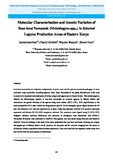| dc.contributor.author | Gichuki, Charity | |
| dc.contributor.author | Wanjohi, Waceke | |
| dc.contributor.author | Runo, Steven | |
| dc.date.accessioned | 2018-08-14T08:38:21Z | |
| dc.date.accessioned | 2020-02-07T05:37:52Z | |
| dc.date.available | 2018-08-14T08:38:21Z | |
| dc.date.available | 2020-02-07T05:37:52Z | |
| dc.date.issued | 2016 | |
| dc.identifier.uri | http://repository.must.ac.ke/handle/123456789/1132 | |
| dc.description.abstract | Root-knot nematodes are sedentary endoparasites of plant roots and the primary nematode pathogens of most cultivated crops worldwide, including legumes. Root- Knot Nematodes of the genus Meloidogyne is the most economically important nematode pests affecting cowpea and pigeon pea in Eastern Kenya. This study sought to identify the Meloidoigyne species of root-knot nematodes on selected legumes in Mbeere district and characterize the genetic diversity of the species using small subunit (SSU) rDNA. PCR amplifications of the extracted purified DNA were carried out using primers specific for the intergenic spacer region between the 5S and 18S ribosomal DNA and the expected size of about 720bp was obtained. Purified PCR products were then sequenced and thirteen 5S-18S rDNA sequences obtained. The sequences were aligned using CLUSTALW2, Sequence statistics, pairwise differences, and estimates of divergence were determined with MEGA5. Nucleotide diversities were estimated in DnaSPv5. Phylogenetic tree was drawn using Phylowin and edited in MEGA5. From the findings of the study it has been established that root knot nematodes affecting the cowpea and pigeon pea in Mbeere district are M. javanica, M. incognita and M. arenaria. Judging from the extent of differences in base composition biases between sequences, it was concluded that the sequences under study have not evolved with the same pattern of substitution.Sequences from the species under study were closely related to sequences retrieved from sequences databases especially those sequences which were less divergent due to less substitutions, deletions and insertions. It can be concluded that SSUrDNA are useful in identification, inferring genetic diversity and phylogenetic relationships between the isolated root knot nematodes. There is need for a rapid and reliable method to identify populations of root-knot nematodes in order to design effective control programs. | en_US |
| dc.language.iso | en | en_US |
| dc.publisher | Global Society of Scientific Research and Researchers | en_US |
| dc.subject | Phylogenetic relationships between the Meloidogyne species; | en_US |
| dc.subject | Intergenic region between 18S and 5S genes; | en_US |
| dc.subject | SSU rDNA analysis; Mbeere. | en_US |
| dc.title | Molecular Characterization and Genetic Variation of Root-knot Nematode (Meloidogyne spp.,) in Selected Legume Production Areas of Eastern Kenya | en_US |
| dc.type | Article | en_US |

